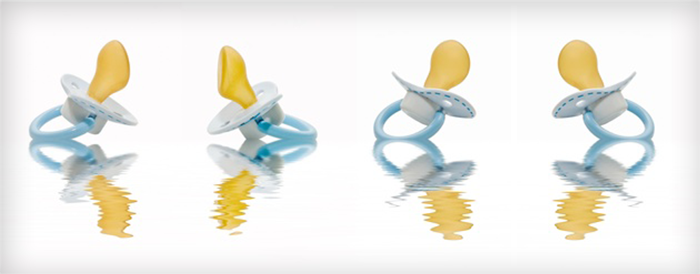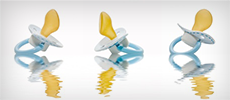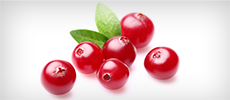Featured Posts

Maternity and Breastfeeding Blog
PACIFIERS: TYPES, RECOMMENDATIONS AND RISKS
Recently a certain controverse about the use of pacifiers has emerged as a means to calm babies. The use of pacifiers to confort babies is being extended in our western society, but there are contradictory opinions regarding its suitability. We will take a look to the benefits and risks it has, and how and how long it should be used.
The sucking reflex of babies appears in the first few days of life, in order to permit the feeding through lactation, but which is also used by the baby to confort himself by sucking his thumb or other objects, since it has a pleasant effect.
Benefits of the use of pacifiers:
- it improves coordination in sucking-swallowing
- it stimulates gastrointestinal functions
- it is related to less cases of sudden infant death syndrom, since the pacifier prevents the tongue to obstruct respiratory tract.
Types of pacifiers:
- According to the type of teat: rubber (latex) or silicone. Latex pacifiers are very resistent, so that they are suitable for the stage of his first teeth. However, silicone pacifiers are teared with the teeth, so although they are harder and easily washable, they are not recommended for the dentition stage of the breastfed baby.
- According to the size of teat. Smaller pacifiers are for younger babies, therefore we can find pacifiers for premature or newborn babies with low weight or for infants aged 18 months or more.
- Según la forma de la tetina According to the form of teat:
- Classic
- Anatomical: they imitate the shape of the nipple while sucking
- Drop-shapped: flatter and thinner than classics
- According to the number of pieces:
- One piece: all the pacifier is made with the same material (rubber or silicone), they are safer and more easily washable, although less beautiful. They are less used than those of multiple pieces because they are less showy.
- Multiple pieces: The pacifier is made with rigid plastic, exept the teat, which is made of silicone or rubber. There is a higher hazard risk because of the loosening of any of the pieces and however they are more used because they are more attractive. .
Usage recommendations of pacifiers:
- Never before the first 15 days, before the breastfeeding is correctly established.
- Never after 1 year.
- Restriction in its use from 8 months is recommended.
- It should be used to relax the newborn baby and then removed after 10 minutes, never use every time the baby cries.
- Conserve and clean conscientiously and use another when a crack is appeared.
- Not to impregnate with sweet substances, since it can contribute to tooth decay.
- Be very careful with the use of chains to hang the pacifier, because they can provoque the chocking of the baby. It is better to use authorised chains, with safety bealts which are tied to the clothes or to the crib.
Risks of the use of pacifiers that you should know:
- Failure in breastfeeding
- Tooth deformities, tooth decay, and cold sores.
- Risk of otitis and allergy to latex.
- Sleep distrubance.
The pacifiers which are sold in Spanish pharmacies are regulated by an European quality standard which assures that materials and structure are suitable for their use (EN 1400-1), therefore with a good usage, our children will benefit of it, thus minimizing the risks.
Sucking is a normal activity of the development of foetus and newborn babies. The pacifier has benefits and produces a calming effect but it should not be used to stop every cry of the baby. The cry of a baby is a part of his communication and it you have to look after it according to his needs.
Amapola Munuera
Pharmacist
References:
http://www.nichd.nih.gov/publications/pubs/Documents/SAD_Ponga_a_su_bebe_espanol_2013.pdf
http://kidshealth.org/parent/en_espanol/nutricion/breastfeed_starting_esp.html
Our category link: http://www.farmaciacampoamor.com/en/633-pacifiers-and-accessories




